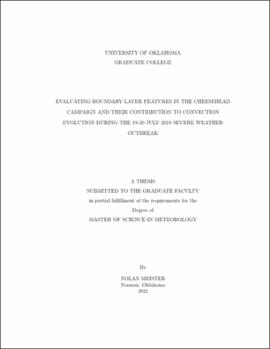| dc.description.abstract | Interactions between the atmospheric boundary layer and convective storms provide an opportunity for research bridging the two meteorological fields. Despite this, there remains a pervasive sense within the meteorological community that the atmospheric boundary layer (ABL) and convection are two separate fields of research. The CHEESEHEAD 2019 project was conducted in northern Wisconsin to study boundary layer responses to spatial heterogeneities. During the project, a multiple-day severe weather event occurred near and south of the CHEESEHEAD domain from 19-20 July 2019, which was forecasted by the NSSL Warn on Forecast Ensemble System (WoFS) ensemble model. This confluence of factors made the case ideally suited for a cross-discipline study into boundary layer evolution and convection evolution.
Boundary layer evolution was studied by comparing composited characteristics within the boundary layer across two remote profiling datasets --- one collected in central Oklahoma in July 2020, and a CHEESEHEAD dataset from Wisconsin in July 2019. It was found that the Oklahoma dataset, despite having a more statically stable boundary layer, was more turbulent than the Wisconsin boundary layer. In Oklahoma a strong nocturnal LLJ developed, with the meridional component developing earlier in the evening than the zonal component. In Wisconsin no evidence of a meridional LLJ was found --- however, there was evidence of a weak zonal LLJ. These results show that boundary layer features may vary considerably across spatial regimes, although the scales of those feature variabilities are uncertain from these results.
These characteristics informed the WoFS verification study, which was performed across three regimes of severe weather on 19-20 July. WoFS low-level wind forecasts ahead of a tornadic supercell were compared to a CHEESEHEAD radar wind profiler, which found that WoFS overestimated low-level shear ahead of the supercell. The second regime was a derecho that merged with the supercell, producing significant wind damage. WoFS wind gust forecasts were too far south with the significant wind potential from this regime, with damaging wind potential aided by a statically unstable boundary layer. The third regime was a line of tornadic severe storms the next morning along a stalled outflow boundary. WoFS forecasted the location of the outflow boundary well, and the boundary’s stall was influenced by the LLJ. These results show strengths and weaknesses of WoFS within certain convection regimes. Furthermore, the results of this work contextualize the influence of boundary layer features on convection evolution and show the benefits that forecasters and researchers may glean from considering the two fields in tandem. | en_US |
